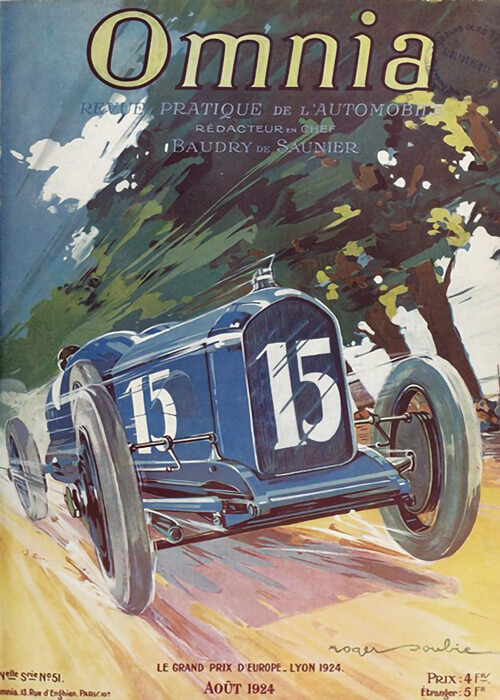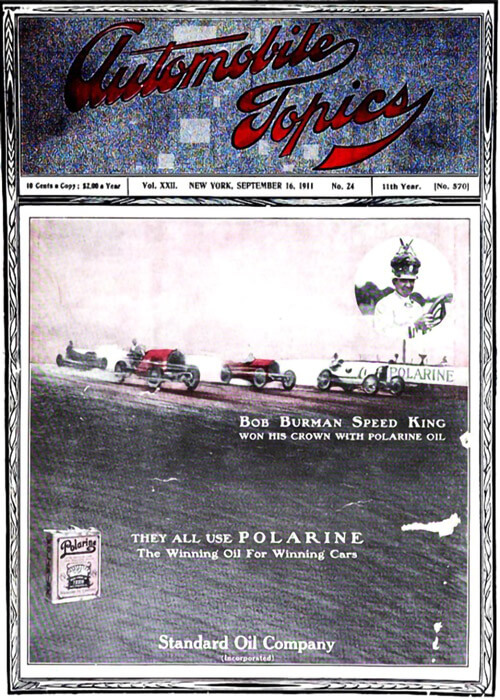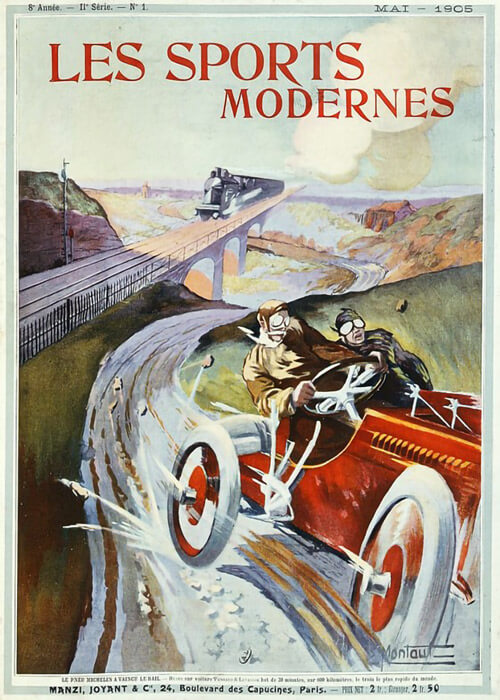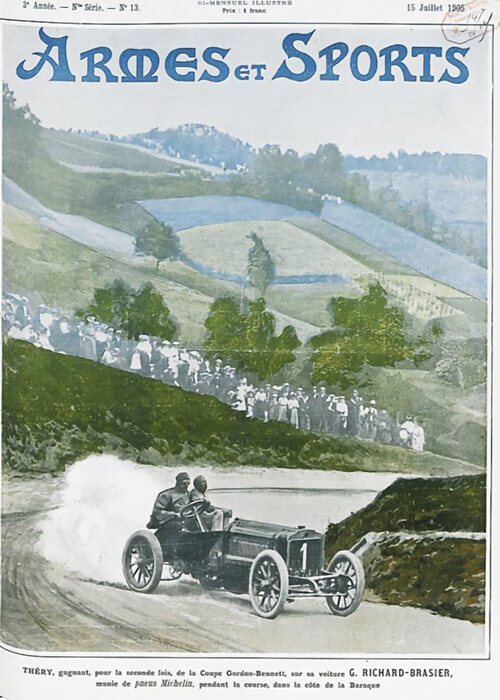In this article preceding the 1913 Indianapolis Sweepstakes, The Automobile Journal introduces many aspects of preparation for the race. Prize money is discussed, visiting foreign persons of automotive importance are mentioned and most of all, the participating drivers and cars are presented.
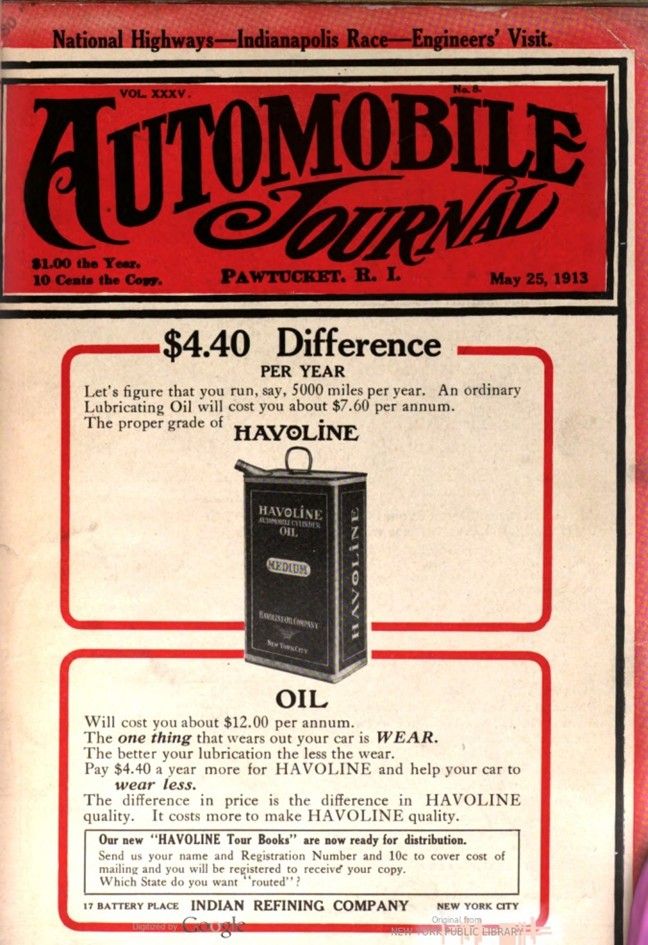
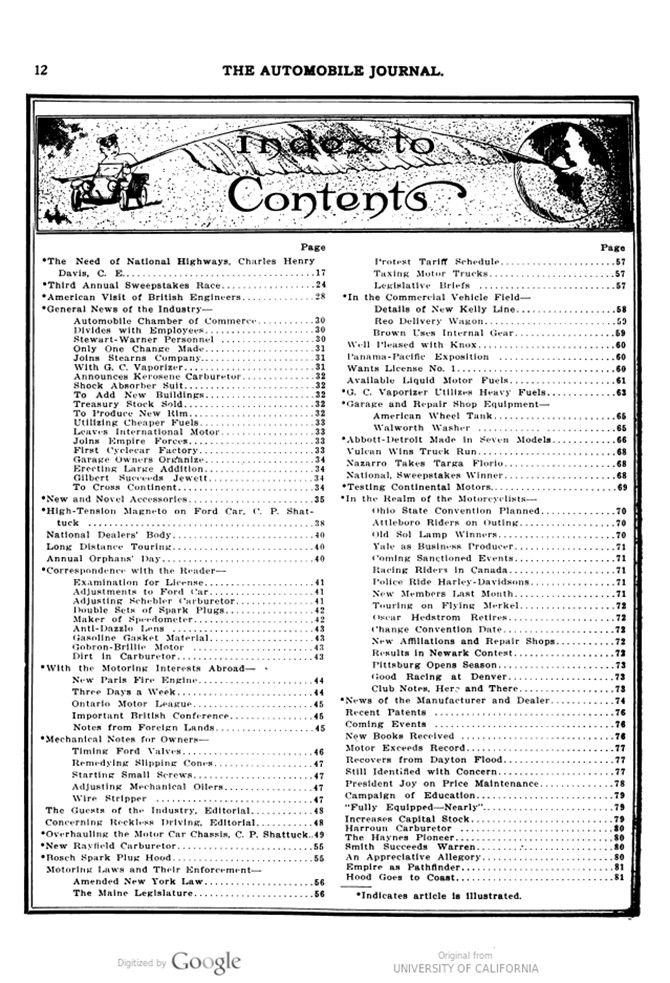
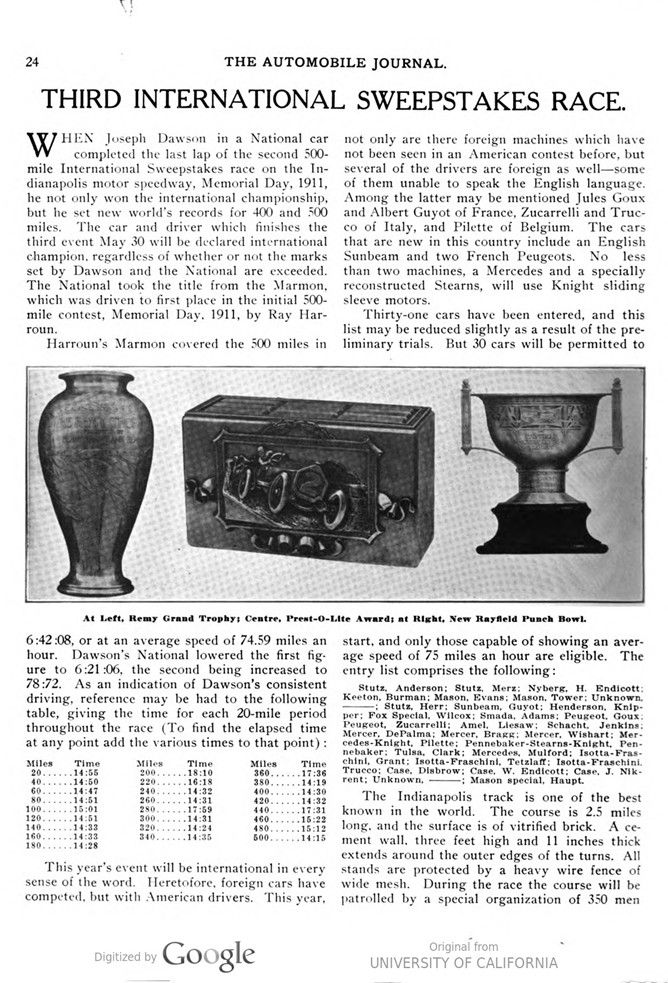
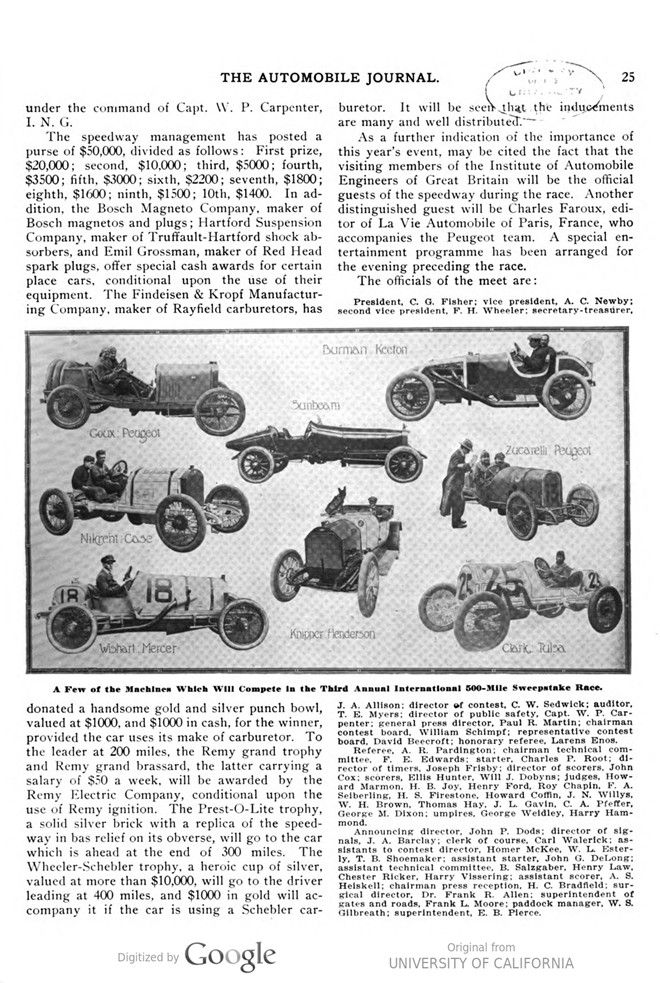
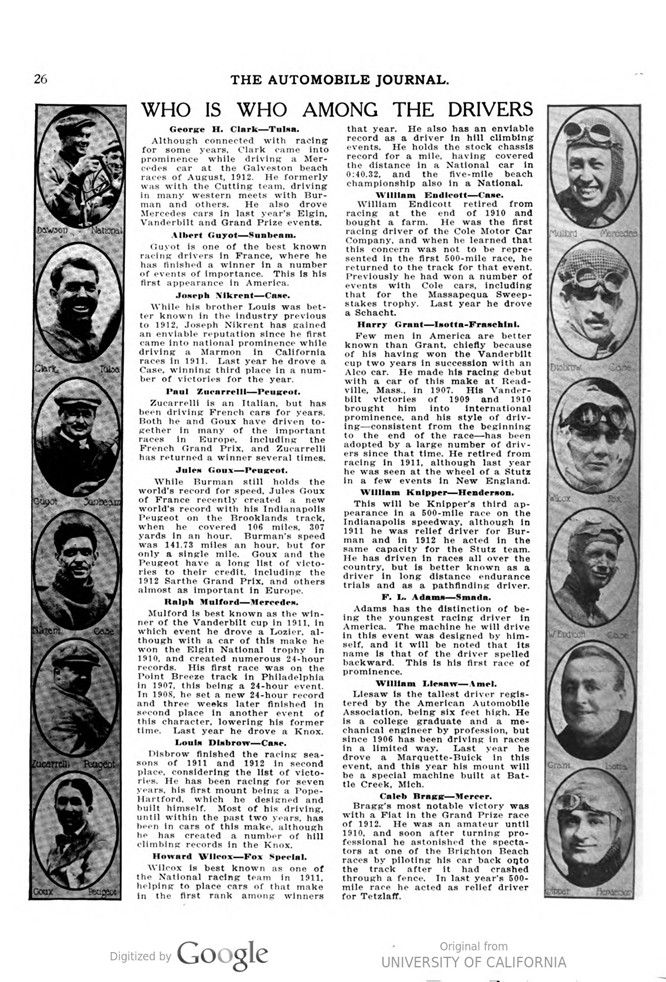
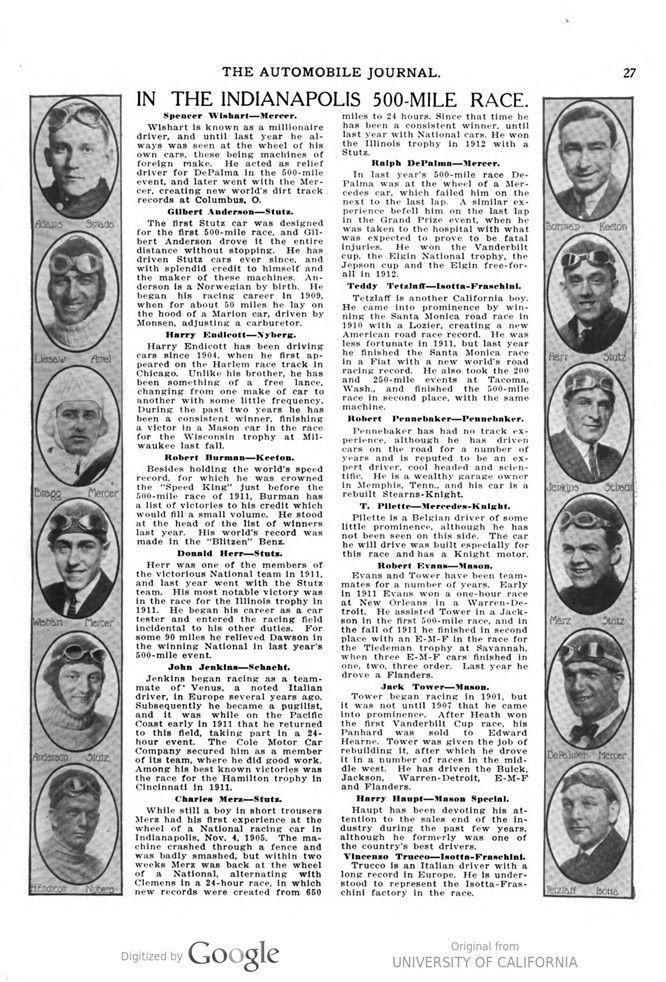
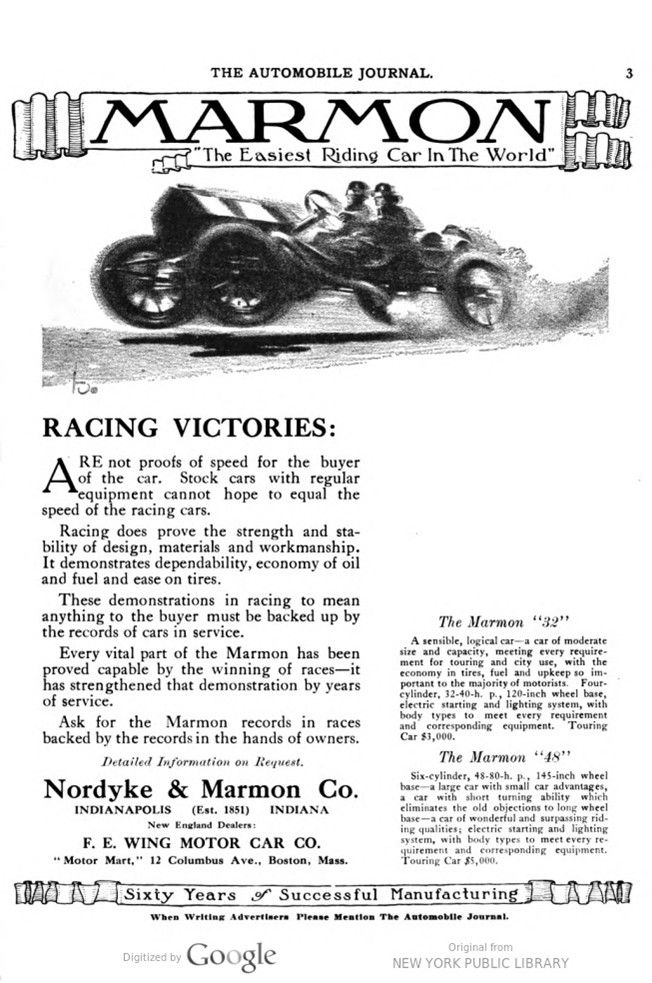
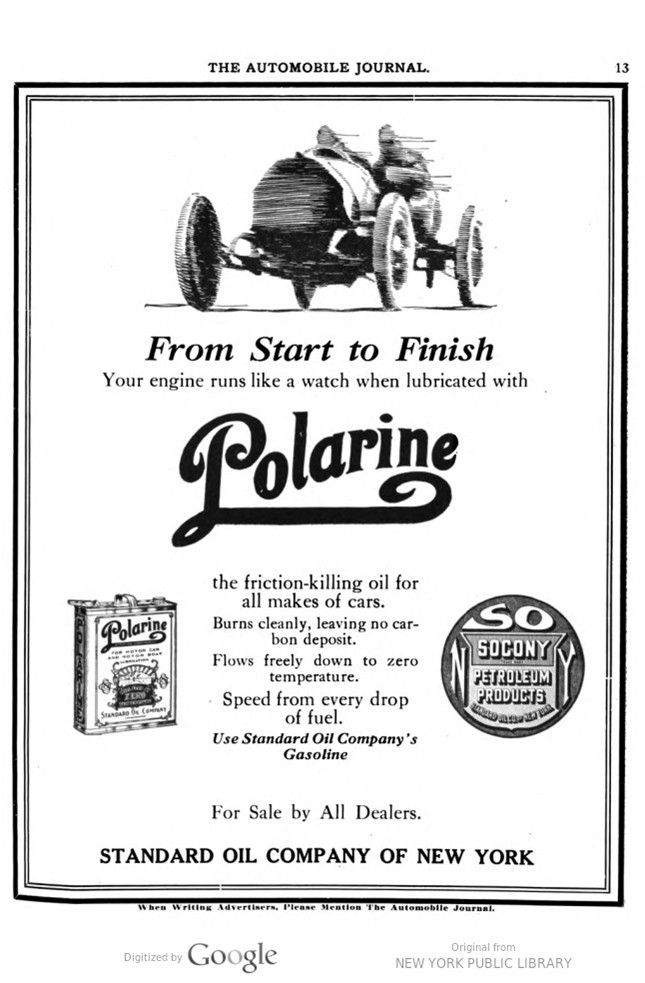
Text and jpegs by courtesy of hathitrust.org www.hathitrust.org, compiled by motorracinghistory.com
The AUTOMOBILE JOURNAL – Vol. XXXV, No. 8, May 25, 1913
THIRD INTERNATIONAL SWEEPSTAKES RACE.
WHEN Joseph Dawson in a National car completed the last lap of the second 500-mile International Sweepstakes race on the Indianapolis motor speedway, Memorial Day, 1911, he not only won the international championship, but he set new world’s records for 400 and 500 miles. The car and driver which finishes the third event May 30 will be declared international champion, regardless of whether or not the marks set by Dawson and the National are exceeded. The National took the title from the Marmon, which was driven to first place in the initial 500- mile contest, Memorial Day, 1911, by Ray Harroun.
Harroun’s Marmon covered the 500 miles in 6:42:08, or at an average speed of 74.59 miles an hour. Dawson’s National lowered the first figure to 6:21:06, the second being increased to 78:72. As an indication of Dawson’s consistent driving, reference may be had to the following table, giving the time for each 20-mile period throughout the race (To find the elapsed time at any point add the various times to that point):
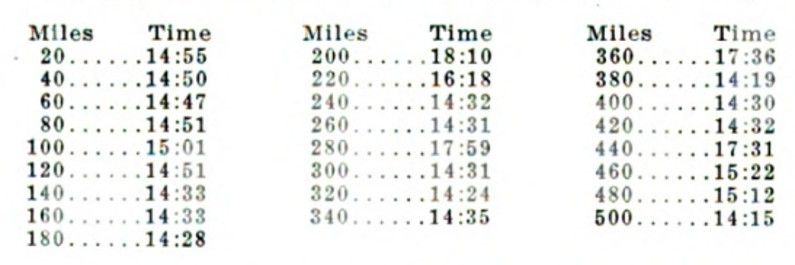
This year’s event will be international in every sense of the word. Heretofore, foreign cars have competed, but with American drivers. This year, not only are there foreign machines which have not been seen in an American contest before, but several of the drivers are foreign as well – some of them unable to speak the English language. Among the latter may be mentioned Jules Goux and Albert Guyot of France, Zucarrelli and Trucco of Italy, and Pilette of Belgium. The cars that are new in this country include an English Sunbeam and two French Peugeots. No less than two machines, a Mercedes and a specially reconstructed Stearns, will use Knight sliding sleeve motors.
Thirty-one cars have been entered, and this list may be reduced slightly as a result of the preliminary trials. But 30 cars will be permitted to start, and only those capable of showing an average speed of 75 miles an hour are eligible. The entry list comprises the following: Stutz, Anderson; Stutz, Merz; Nyberg, H. Endicott; Keeton, Burman; Mason, Evans; Tower, Unknown. ㅡ; Stutz, Herr; Sunbeam, Guyot; Henderson, Knipper; Fox Special, Wilcox; Smada, Adams; Peugeot, Goux; Peugeot, Zucarrelli; Amel, Liesaw; Schacht, Jenkins; Mercer, DePalma; Mercer, Bragg; Mercer, Wishart; Mercedes-Knight, Pilette; Pennebaker-Stearns-Knight, Pennebaker; Tulsa, Clark; Mercedes, Mulford; Isotta-Fraschini, Grant; Isotta-Fraschini, Tetzlaff; Isotta-Fraschini, Trucco; Case, Disbrow; Case, W. Endicott; Case, J. Nik- rent; Unknown, ; Mason special, Haupt.
The Indianapolis track is one of the best known in the world. The course is 2.5 miles long, and the surface is of vitrified brick. A cement wall, three feet high and 11 inches thick extends around the outer edges of the turns. All stands are protected by a heavy wire fence of wide mesh. During the race the course will be patrolled by a special organization of 350 men under the command of Capt. W. P. Carpenter, I. N. G.
The speedway management has posted a purse of $50,000, divided as follows: First prize, $20,000; second, $10,000; third, $5000; fourth, $3500; fifth, $3000; sixth, $2200; seventh, $1800; eighth, $1600; ninth, $1500; 10th, $1400. In addition, the Bosch Magneto Company, maker of Bosch magnetos and plugs; Hartford Suspension Company, maker of Truffault-Hartford shock absorbers, and Emil Grossman, maker of Red Head spark plugs, offer special cash awards for certain place cars, conditional upon the use of their equipment. The Findeisen & Kropf Manufacturing Company, maker of Rayfield carburetors, has donated a handsome gold and silver punch bowl, valued at $1000, and $1000 in cash, for the winner, provided the car uses its make of carburetor. To the leader at 200 miles, the Remy grand trophy and Remy grand brassard, the latter carrying a salary of $50 a week, will be awarded by the Remy Electric Company, conditional upon the use of Remy ignition. The Prest-O-Lite trophy, a solid silver brick with a replica of the speedway in bas relief on its obverse, will go to the car which is ahead at the end of 300 miles. The Wheeler-Schebler trophy, a heroic cup of silver, valued at more than $10,000, will go to the driver leading at 400 miles, and $1000 in gold will accompany it if the car is using a Schebler carburetor. It will be seen that the inducements are many and well distributed.
As a further indication of the importance of this year’s event, may be cited the fact that the visiting members of the Institute of Automobile Engineers of Great Britain will be the official guests of the speedway during the race. Another distinguished guest will be Charles Faroux, editor of La Vie Automobile of Paris, France, who accompanies the Peugeot team. A special entertainment programme has been arranged for the evening preceding the race.
The officials of the meet are:
President, C. G. Fisher; vice president, A. C. Newby; second vice president, F. H. Wheeler; secretary-treasurer, J. A. Allison; director of contest, C. W. Sedwick; auditor, T. E. Myers; director of public safety, Capt. W. P. Carpenter; general press director, Paul R. Martin; chairman contest board, William Schimpf; representative contest board, David Beecroft; honorary referee, Larens Enos. Referee, A. R. Pardington; chairman technical committee, F. E. Edwards; starter, Charles P. Root; director of timers, Joseph Frisby; director of scorers, John Cox; scorers, Ellis Hunter, Will J. Dobyns; judges, Howard Marmon, H. B. Joy, Henry Ford, Roy Chapin, F. A. Seiberling, H. S. Firestone, Howard Coffin, J. N. Willys, W. H. Brown, Thomas Hay, J. L. Gavin, C. A. Pfeffer, George M. Dixon; umpires, George Weidley, Harry Hammond. Announcing director, John P. Dods; director of signals, J. A. Barclay; clerk of course, Carl Walerick; assistants to contest director, Homer McKee, W. L. Esterly, T. B. Shoemaker; assistant starter, John G. DeLong; assistant technical committee, B. Salzgaber, Henry Law, Chester Ricker, Harry Vissering; assistant scorer, A. S. Heiskell; chairman press reception, H. C. Bradfield; surgical director, Dr. Frank R. Allen; superintendent of gates and roads, Frank L. Moore; paddock manager, W. S. Gilbreath; superintendent, E. B. Pierce.
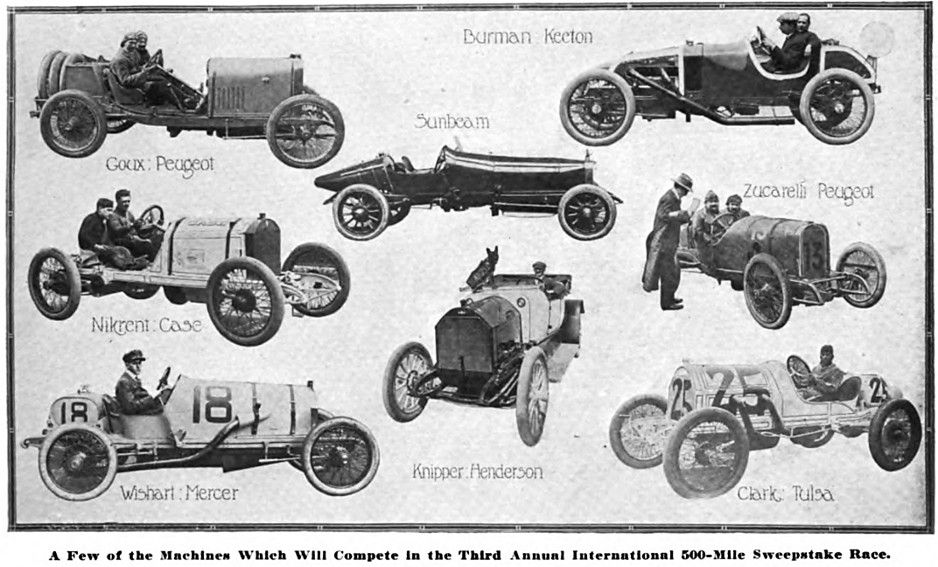
WHO IS WHO AMONG THE DRIVERS IN THE INDIANAPOLIS 500-MILE RACE.
George H. Clark-Tulsa.
Although connected with racing for some years, Clark came into prominence while driving a Mercedes at the Galveston beach races of August, 1912. He formerly was with the Cutting team, driving in many western meets with Burman and others. He also drove Mercedes cars in last year’s Elgin, Vanderbilt and Grand Prize events.
Albert Guyot-Sunbeam.
Guyot is one of the best known racing drivers in France, where he has finished a winner in a number of events of importance. This is his first appearance in America.
Joseph Nikrent-Case.
While his brother Louis was better known in the industry previous to 1912, Joseph Nikrent has gained an enviable reputation since he first came into national prominence while driving a Marmon in California races in 1911. Last year he drove a Case, winning third place in a number of victories for the year.
Paul Zucarrelli-Peugeot.
Zucarrelli is an Italian, but has been driving French cars for years. Both he and Goux have driven together in many of the important races in Europe, including the French Grand Prix, and Zucarrelli has returned a winner several times.
Jules Goux-Peugeot.
While Burman still holds the world’s record for speed, Jules Goux of France recently created world’s record with his Indianapolis Peugeot on the Brooklands track, when he covered 106 miles, 307 yards in an hour. Burman’s speed was 141.73 miles an hour, but for only a single mile. Goux and the Peugeot have a long list of victories to their credit, including the 1912 Sarthe Grand Prix, and others almost as important in Europe.
Ralph Mulford-Mercedes.
Mulford is best known as the winner of the Vanderbilt cup in 1911, in which event he drove a Lozier, although with a car of this make he won the Elgin National trophy in 1910, and created numerous 24-hour records. His first race was on the Point Breeze track in Philadelphia in 1907, this being a 24-hour event. In 1908, he set a new 24-hour record and three weeks later finished in second place in another event of this character, lowering his former time. Last year he drove a Knox.
Louis Disbrow-Case.
Disbrow finished the racing seasons of 1911 and 1912 in second place, considering the list of victories. He has been racing for seven years, his first mount being a Pope-Hartford, which he designed and built himself. Most of his driving, until within the past two years, has been in cars of this make, although he has created a number of hill climbing records in the Knox.
Howard Wilcox-Fox Special.
Wilcox is best known as one of the National racing team in 1911, helping to place cars of that make in the first rank among winners that year. He also has an enviable record as a driver in hill climbing events. He holds the stock chassis record for a mile, having covered the distance in a National car in 0:40.32, and the five-mile beach championship also in a National.
William Endicott-Case.
William Endicott retired from racing at the end of 1910 and bought a farm. He was the first racing driver of the Cole Motor Car Company, and when he learned that this concern was not to be represented in the first 500-mile race, he returned to the track for that event. Previously he had won a number of events with Cole cars, including that for the Massapequa Sweep- stakes trophy. Last year he drove a Schacht.
Harry Grant-Isotta-Fraschini.
Few men in America are better known than Grant, chiefly because of his having won the Vanderbilt cup two years in succession with an Alco car. He made his racing debut with a car of this make at Readville, Mass., in 1907. His Vanderbilt victories of 1909 and 1910 brought him into international prominence, and his style of driving consistent from the beginning to the end of the race has been adopted by a large number of drivers since that time. He retired from racing in 1911, although last year he was seen at the wheel of a Stutz in a few events in New England.
William Knipper-Henderson.
This will be Knipper’s third appearance in a 500-mile race on the Indianapolis speedway, although in 1911 he was relief driver for Bur- man and in 1912 he acted in the same capacity for the Stutz team. He has driven in races all over the country, but is better known as a driver in long distance endurance trials and as a pathfinding driver.
F. L. Adams-Smada.
Adams has the distinction of being the youngest racing driver in America. The machine he will drive in this event was designed by himself, and it will be noted that its name is that of the driver spelled backward. This is his first race of prominence.
William Liesaw-Amel.
Liesaw is the tallest driver registered by the American Automobile Association, being six feet high. He is a college graduate and a mechanical engineer by profession, but since 1906 has been driving in races in a limited way. Last year he drove Marquette-Buick in this event, and this year his mount will be a special machine built at Battle Creek, Mich.
Caleb Bragg-Mercer.
Bragg’s most notable victory was with a Fiat in the Grand Prize race of 1912. He was an amateur until 1910, and soon after turning professional he astonished the spectators at one of the Brighton Beach races by piloting his car back onto the track after it had crashed through a fence. In last year’s 500- mile race he acted as relief driver for Tetzlaff.
Spencer Wishart-Mercer.
Wishart is known as a millionaire driver, and until last year he always was seen at the wheel of his own cars, these being machines of foreign make. He acted as relief driver for DePalma in the 500-mile event, and later went with the Mercer, creating new world’s dirt track records at Columbus, O.
Gilbert Anderson-Stutz.
The first Stutz car was designed for the first 500-mile race, and Gilbert Anderson drove it the entire distance without stopping. He has driven Stutz cars ever since, and with splendid credit to himself and the maker of these machines. Anderson is a Norwegian by birth. He began his racing career in 1909, when for about 50 miles he lay on the hood of a Marion car, driven by Monsen, adjusting a carburetor.
Harry Endicott-Nyberg.
Harry Endicott has been driving cars since 1904, when he first appeared on the Harlem race track in Chicago. Unlike his brother, he has been something of a free-lance, changing from one make of car to another with some little frequency. During the past two years he has been a consistent winner, finishing a victor in a Mason car in the race for the Wisconsin trophy at Milwaukee last fall.
Robert Burman-Keeton.
Besides holding the world’s speed record, for which he was crowned the „Speed King“ just before the 500-mile race of 1911, Burman has a list of victories to his credit which would fill a small volume. He stood at the head of the list of winners last year. His world’s record was made in the „Blitzen“ Benz.
Donald Herr-Stutz.
Herr was one of the members of the victorious National team in 1911, and last year went with the Stutz team. His most notable victory was in the race for the Illinois trophy in 1911. He began his career as a car tester and entered the racing field incidental to his other duties. For some 90 miles he relieved Dawson in the winning National in last year’s 500-mile event.
John Jenkins-Schacht.
Jenkins began racing as a teammate of Venus, noted Italian driver, in Europe several years ago. Subsequently he became a pugilist, and it was while on the Pacific Coast early in 1911 that he returned to this field, taking part in a 24- hour event. The Cole Motor Car Company secured him as a member of its team, where he did good work. Among his best known victories was the race for the Hamilton trophy in Cincinnati in 1911.
Charles Merz-Stutz.
While still a boy in short trousers Merz had his first experience at the wheel of a National racing car in Indianapolis, Nov. 4, 1905. The ma- chine crashed through a fence and was badly smashed, but within two weeks Merz was back at the wheel of National, alternating with Clemens in a 24-hour race, in which new records were created from 650 miles to 24 hours. Since that time he has been a consistent winner, until last year with National cars. He won the Illinois trophy in 1912 with a Stutz.
Ralph DePalma-Mercer.
In last year’s 500-mile race DePalma was at the wheel of a Mercedes car, which failed him on the next to the last lap. A similar experience befell him on the last lap in the Grand Prize event, when he was taken to the hospital with what was expected to prove to be fatal injuries. He won the Vanderbilt cup, the Elgin National trophy, the Jepson cup and the Elgin free-for-all in 1912.
Teddy Tetzlaff-Isotta-Fraschini.
Tetzlaff is another California boy. He came into prominence by winning the Santa Monica road race in 1910 with a Lozier, creating a new American road race record. He was less fortunate in 1911, but last year he finished the Santa Monica race in a Fiat with a new world’s road racing record. He also took the 200 and 250-mile events at Tacoma, Wash., and finished the 500-mile race in second place, with the same machine.
Robert Pennebaker-Pennebaker.
Pennebaker has had no track experience, although he has driven cars on the road for a number of years and is reputed to be an ex- pert driver, cool headed and scientific. He is a wealthy garage owner in Memphis, Tenn., and his car is a Jenkins rebuilt Stearns-Knight.
T. Pilette-Mercedes-Knight.
Pilette is a Belgian driver of some little prominence, although he has not been seen on this side. The car he will drive was built especially for this race and has a Knight motor.
Robert Evans-Mason.
Evans and Tower have been teammates for a number of years. Early in 1911 Evans won a one-hour race at New Orleans in Warren-Detroit. He assisted Tower in a Jack- son in the first 500-mile race, and in the fall of 1911 he finished in second place with an E-M-F in the race for the Tiedeman trophy at Savannah, when three E-M-F cars finished in one, two, three order. Last year he drove a Flanders.
Jack Tower-Mason.
Tower began racing in 1901, but it was not until 1907 that he came into prominence. After Heath won the first Vanderbilt Cup race, his Panhard was sold to Edward Hearne. Tower was given the job of rebuilding it, after which he drove it in a number of races in the middle west. He has driven the Buick, Jackson, Warren-Detroit, E-M-F and Flanders.
Harry Haupt-Mason Special.
Haupt has been devoting his attention to the sales end of the industry during the past few years, although he formerly was one of the country’s best drivers.
Vincenzo Trucco-Isotta-Fraschini.
Trucco is an Italian driver with a long record in Europe. He is understood to represent the Isotta-Fraschini factory in the race.
Photo captions.
Page 24. THE REMY TROPHY – RAYFIELD TROPHY – At Left, Remy Grand Trophy; Centre, Prest-O-Lite Award; at Right, New Rayfield Punch Bowl.
Page 25. Burman, Keeton – Sunbeam – Goux: Peugeot – Nikrent: Case – Wishart: Mercer – Knipper, Henderson – Zucarelli, Peugeot – Clark, Tulsa
A Few of the Machines Which Will Compete in the Third Annual International 500-Mile Sweepstake Race.
Page 26. Dawson National – Clark Tulsa – Guyot Sunbeam – Nikrent Case – Zucarrelli Peugeot – Goux Peugeot – Mulford Mercedes – Disbrow Case – Wilcox Fox – W. Endicott Case – Grant Isotta – Knipper Herderson
Page 27. Adams Smada – Liesaw Amel – Bragg Mercer – Wishart Mercer – Anderson Stutz – H. Endicott Nubera – Burman Keeton – Herr Stutz – Jenkins Schacht – Merz Stutz – DePalmer Mercer – Tetzlaff Isotta

